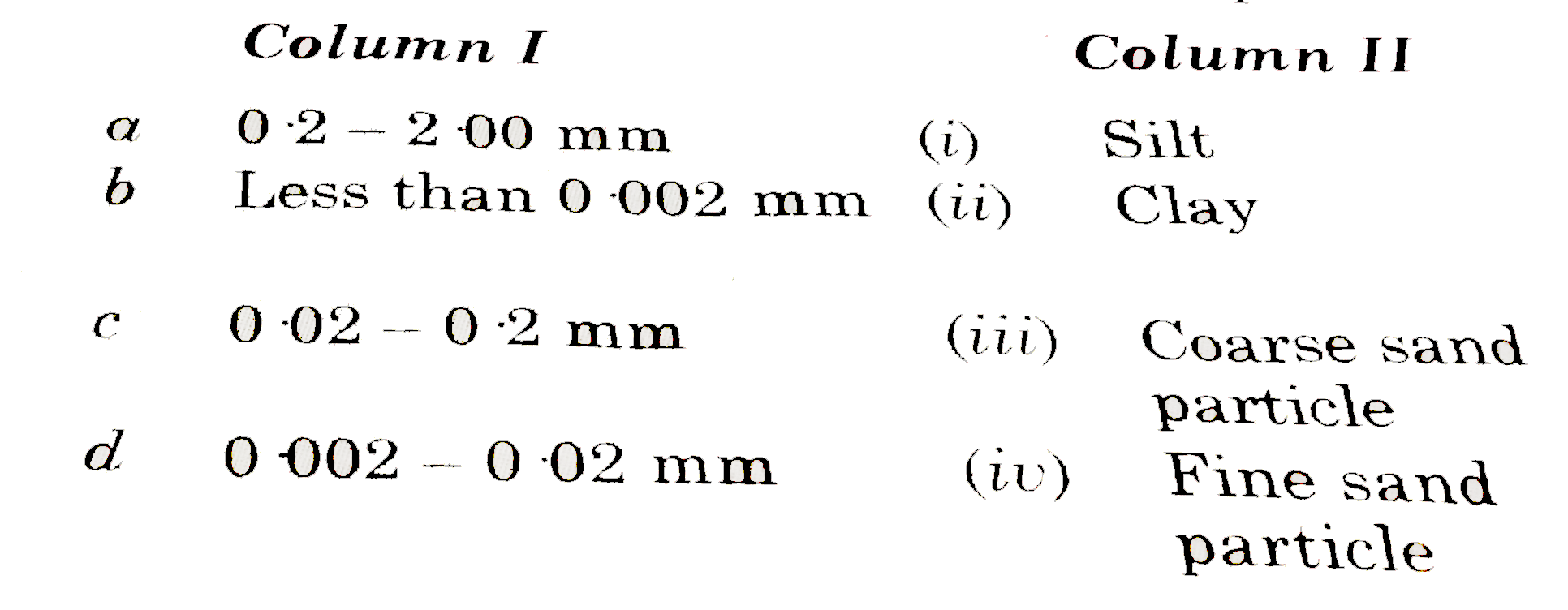Water tightly held to soil particles all of the above
Bound water
Hygrosopic water
Runaway water
all of the above
The correct Answer is:B
Step-by-Step Solution:
1. Understanding Soil Water Types: Water in the soil can be classified into different types based on its availability to plants. The main types include hygroscopic water, bound water, runaway water, and gravitational water.
2. Identifying Hygroscopic Water: Hygroscopic water is the water that is tightly held to soil particles. It is adsorbed onto the surface of soil colloids and is not available for plant uptake. This water is held very firmly and cannot be used by plants.
3. Examining Other Water Types:
- Bound Water: This type of water is chemically bound to soil particles, such as in the case of calcium sulfate, which has water molecules associated with it. Like hygroscopic water, bound water is also unavailable for plants.
- Runaway Water: This water is not retained in the soil; it has been washed away and does not remain in the field. Therefore, it is not held tightly to soil particles.
- Gravitational Water: This water drains through the soil due to gravity and is available for plants, but it is not tightly held.
4. Conclusion: Among the options provided, hygroscopic water is the type that is tightly held to soil particles and is unavailable for plant use. Therefore, the correct answer to the question is hygroscopic water.
5. Final Answer: The water tightly held to soil particles is hygroscopic water.
---
- Bound Water: This type of water is chemically bound to soil particles, such as in the case of calcium sulfate, which has water molecules associated with it. Like hygroscopic water, bound water is also unavailable for plants.
- Runaway Water: This water is not retained in the soil; it has been washed away and does not remain in the field. Therefore, it is not held tightly to soil particles.
- Gravitational Water: This water drains through the soil due to gravity and is available for plants, but it is not tightly held.
Topper's Solved these Questions
- TRANSPORT IN PLANTSBOOK - DINESH PUBLICATION ENGLISHCHAPTER - TRANSPORT IN PLANTSEXERCISE - REVISION QUESTIONS FROM COMPETITIVE EXAMS
425 Videos
- TRANSPORT IN PLANTSBOOK - DINESH PUBLICATION ENGLISHCHAPTER - TRANSPORT IN PLANTSEXERCISE - CHECK YOUR GRASP
40 Videos
- THE LIVING WORLDBOOK - DINESH PUBLICATION ENGLISHCHAPTER - THE LIVING WORLDEXERCISE - Check your grasp
12 Videos
- VERTEBRATA-AGNATHA AND PISCESBOOK - DINESH PUBLICATION ENGLISHCHAPTER - VERTEBRATA-AGNATHA AND PISCESEXERCISE - Check Your Grasp
12 Videos
Similar Questions
Knowledge Check
Which of the following is an ecosystem service provided by a natural ecosystem?
1. Cycling of nutrients
2. Prevention of soil erosion
3. Pollutant absorption and reduction of the threat of gloobal warming
4. All of the aboveACycling of nutrientsBPrevention of soil erosionCPollutant absorption and reduction of the threat of gloobal warmingDAll of the aboveThe water left in the dry soils is generally the
Agravitational waterBhygroscopic waterCcapillary waterDwater in water table
Two particles are simultaneously thrown in horizontal direction from two points on a riverbank, which are at certain height above the water surface. The initial velocities of the particles are v1=5m/sandv2=7.5m/s respectively. Both particles fall into the water at the same time. First particles enters the water at a point s = 10 m from the bank. Determine
(a) the time of flight of the two particles,
(b) the height from which they are thrown,
(c) the point where the second particle falls in water.
View SolutionMatch the columns of size with soil particles

View SolutionWater potential of soil quantified in term of
View SolutionWhen plant absorbs water from the soil, the water potential of the root cell is ........................ than the soil.
View SolutionWhen plant absorbs water from the soil, the water potential of the root cell is _____________ than the soil.
View SolutionWhy a glass bottle completely filled with water and tightly closed at room temperature is likely to burst when kept in the freezer of a refrigerator.
View Solution
